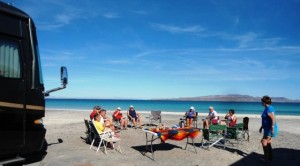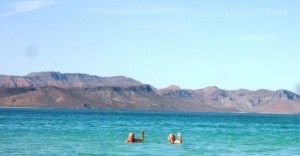
February 21, 2014 – We arrived yesterday in Cabo San Lucas and the heat that started at the beginning of the tour continues. We hit 30c or 86f yesterday, a far cry from when we arrived in Rancho Verde, located south of La Paz on Hwy 1 at 1800’, where it was 38c or 100f!
After Loreto and a short stay at Palapa 206 we headed off to Playa Tecolote just north of La Paz. We enjoyed some of the best that Tecolote could offer, calm water, hardly any wind and spectacular sunshine. On arrival and after set up we got the SUP and Kayak off the van and into the water which we found to be warmer than usual and no stingrays in site. The next day was fabulous, even better then the day before, the water was absolutely flat most of the day and folks were out in the Kayak and on the SUP, we also set the floating chairs out, they were a big hit. Interesting enough the winds came up strong each overnight and kept everyone bouncing to sleep. Rod & Barb hosted a Burrito Breakfast and later our Potluck was great as always plus.


Rod has wood in his truck so we had a beach fire as well. Lots of wonderful memories made at Tecolote on this tour!
Our drive to Rancho Verde went smoothly with little interruption other then the continued construction on the Hwy 1 just over the bridge, this should be completed for next season. It was great to see Tony & Shari in El Triunfo with their friends Tom & Sharon. They joined us for brunch at the El Triunfo Cafe which is always a priority for our stop, the group was really impressed with what Mark has accomplished as this little town continues to revitalize. The gang had a good walk El Triunfo around then off to Rancho Verde. We drove Rod’s truck up to Dal & Donna’s Casita on Dove Tail Road for a tour and they joined us later for campfire hot dogs and we all enjoyed some blues from Dal.

Yesterday we stopped at the Tropic of Cancer and later for propane before entering San Jose Del Cabo. It was great to see Mike & Kelly when we got Villa Serena, they are joining us for a few days on the tour. They hosted the Mid-America RV Show for us in January which has already resulted in some bookings! Our first excursion included a stop at the Glass Blown Factory, a tour around Cabo and a stop at the Sunset de Mona Lisa. We were able to get out on an upper patio as wedding was underway. Last night most headed off to Vag’s for dinner, lots of fun and good food. We also watched the end of the Women’s gold medal hockey game, very exciting for sure.

Today we were off first thing to or favourite stuff store, Artisano’s, for a look see and possible shopping, return to the RV Park then San Jose Del Cabo, always on everyone’s to do list, particularly the Art District. I was able to catch most of the Men’s Hockey game between Canada and the USA. Canada won , 1-0 and are now off to the Gold Medal game against Sweden I believe. The group really enjoyed San Jose and we returned to Villa Serena about 3pm. Later Lisa & I joined Mike & Kelly for dinner at the new Ramuri Brewery in Cabo and a walk about downtown, it seemed empty for mid-February. Tomorrow we are off to Playa Santa Maria.
Go Canada Go!
Did you know?

A rip current, commonly referred to simply as a rip, or by the misnomer rip tide, is a strong channel of water flowing seaward from near the shore, typically through the surf line. These can be commonly experienced on the Pacific and southern Sea of Cortez particularly near where these bodies of water transition. Typical flow is at 0.5 metres per second (1–2 feet per second), and can be as fast as 2.5 metres per second (8 feet per second), which is faster than any human swimmer. They can move to different locations on a beach break, up to tens of metres (a few hundred feet) a day. They can occur at any beach with breaking waves, including oceans, seas, and large lakes.

Causes and occurrence

When wind and waves push water toward the shore, that water is often forced sideways by the oncoming waves. This water streams along the shoreline until it finds an exit back to the sea or open lake water. The resulting rip current is usually narrow and located in a trench between sandbars, under piers or along jetties. A common misconception is that ordinary undertow or even rip currents are strong enough to pull someone under the surface of the water; in reality the current is strongest at the surface. This strong surface flow tends to damp incoming waves, leading to the illusion of a particularly calm part of the sea, which may possibly lure some swimmers into the area. The off-shore path taken by a rip current can be demonstrated by placing colored dye at the start of a current at the shoreline.

Rip currents are stronger when the surf is rough (such as during high onshore winds, or when a strong hurricane is far offshore) or when the tide is low. A more theoretical description involves a quantity known as radiation stress. This is the force (or momentum flux) exerted on the water column by the presence of the wave. As a wave shoals and increases in wave height prior to breaking, radiation stress increases. To balance this, the mean surface (the water level with the wave averaged out) decreases—this is known as setdown. As the wave breaks and continues to reduce in height, the radiation stress decreases. To balance this force, the mean surface increases—this is known as setup. Rip currents can potentially occur wherever strong longshore variability in wave breaking exists. This variability may be caused by sandbars or even by crossing wave trains.
Dangers

Rip currents are a source of danger for people in ocean and lake surf, dragging swimmers away from the beach. Death by drowning comes following exhaustion while fighting the current. Although a rare event, rip currents can be deadly for non-swimmers as well, a person standing waist deep in water can be dragged into deeper waters, where they can drown if they are unable to swim and are not wearing a flotation device. Varying topography makes some beaches more likely to have rip currents; a few are notorious. Rip currents cause more than 100 deaths annually in the United States. Rip currents cause 80% of rescues needed by beach lifeguards.
Usefulness
Rip currents are often used by those who wish to leave the shoreline and want to conserve energy, such as surfers, body boarders, and kayakers.
Escaping a rip current

A swimmer caught in a rip current should not attempt to swim back to shore directly against the rip. This risks exhaustion and drowning. It is pointless trying to fight against a rip current because the rip current will always win. A rip does not pull a swimmer under water; it simply carries the swimmer away from the shore and out to sea in a narrow channel of water. The rip is like a treadmill which the swimmer needs to step off. The swimmer should quickly recognise what is happening, then remain calm and swim parallel to the shore until he or she is outside of the current. Depending on the situation, the swimmer may need to travel a hundred metres (or more) parallel to the shore before reaching a place where they are able to swim back to dry land.
 When attempting to swim back to shore, locations to aim for are places where waves are breaking. In these areas, floating objects are generally transported towards the beach. A swimmer in a strong rip, who is unable to swim away from it, should relax and calmly float or tread water to conserve energy. Eventually the rip will lose strength, and the swimmer can swim at a leisurely pace, in a diagonal direction, away from the rip but back to shore. Coastal swimmers should understand the danger of rip currents, learn how to recognize them and how to escape from them, and swim in areas where lifeguards are operating, whenever possible.
When attempting to swim back to shore, locations to aim for are places where waves are breaking. In these areas, floating objects are generally transported towards the beach. A swimmer in a strong rip, who is unable to swim away from it, should relax and calmly float or tread water to conserve energy. Eventually the rip will lose strength, and the swimmer can swim at a leisurely pace, in a diagonal direction, away from the rip but back to shore. Coastal swimmers should understand the danger of rip currents, learn how to recognize them and how to escape from them, and swim in areas where lifeguards are operating, whenever possible. 


